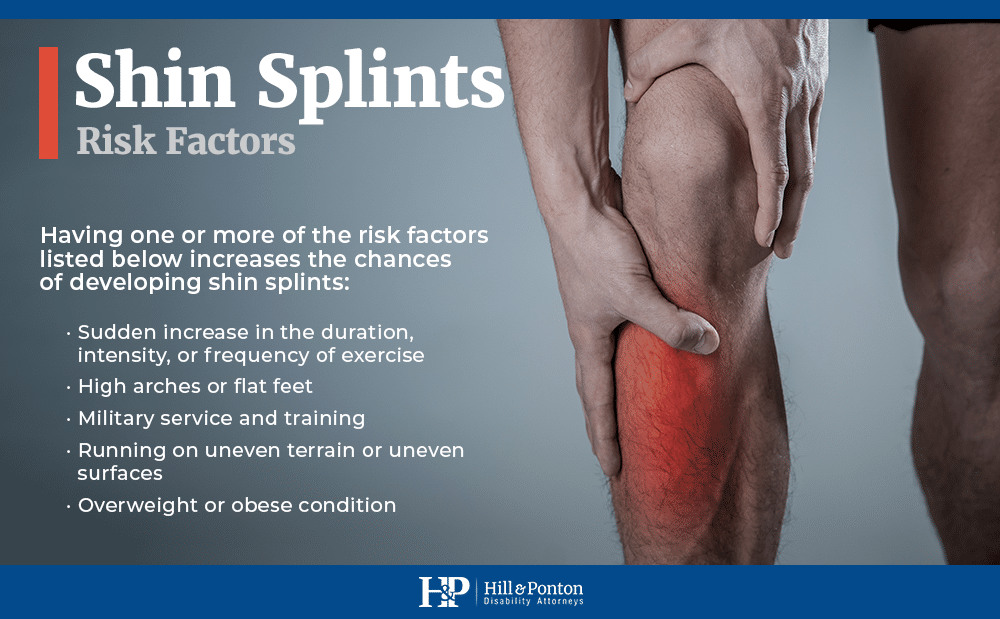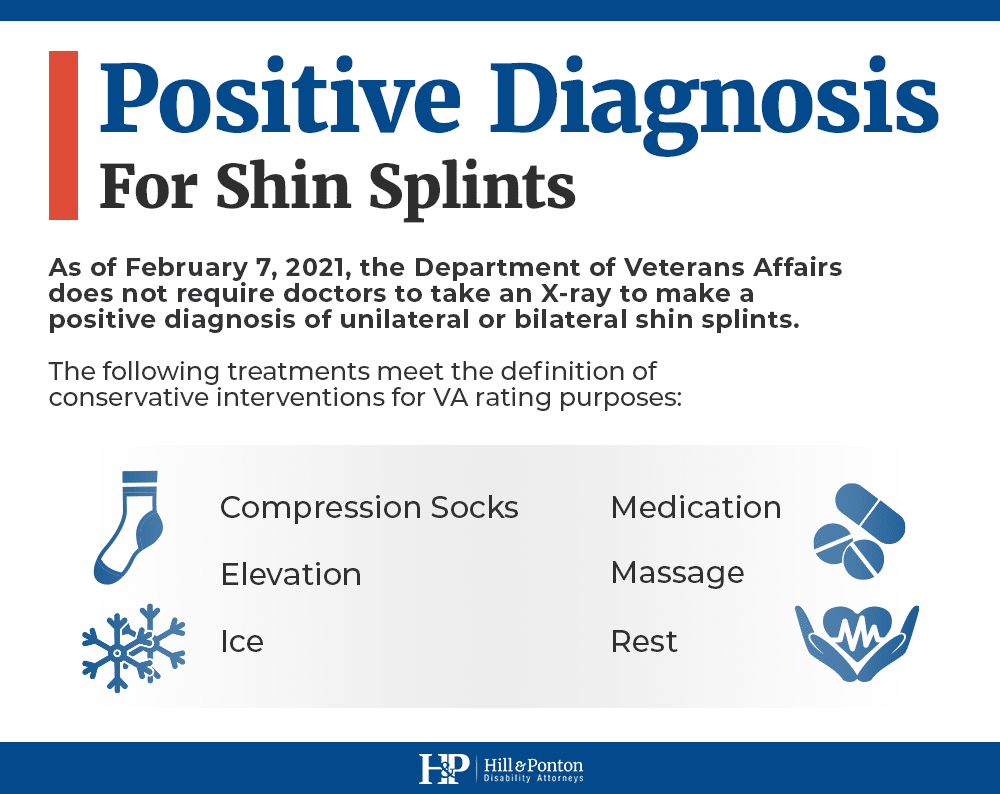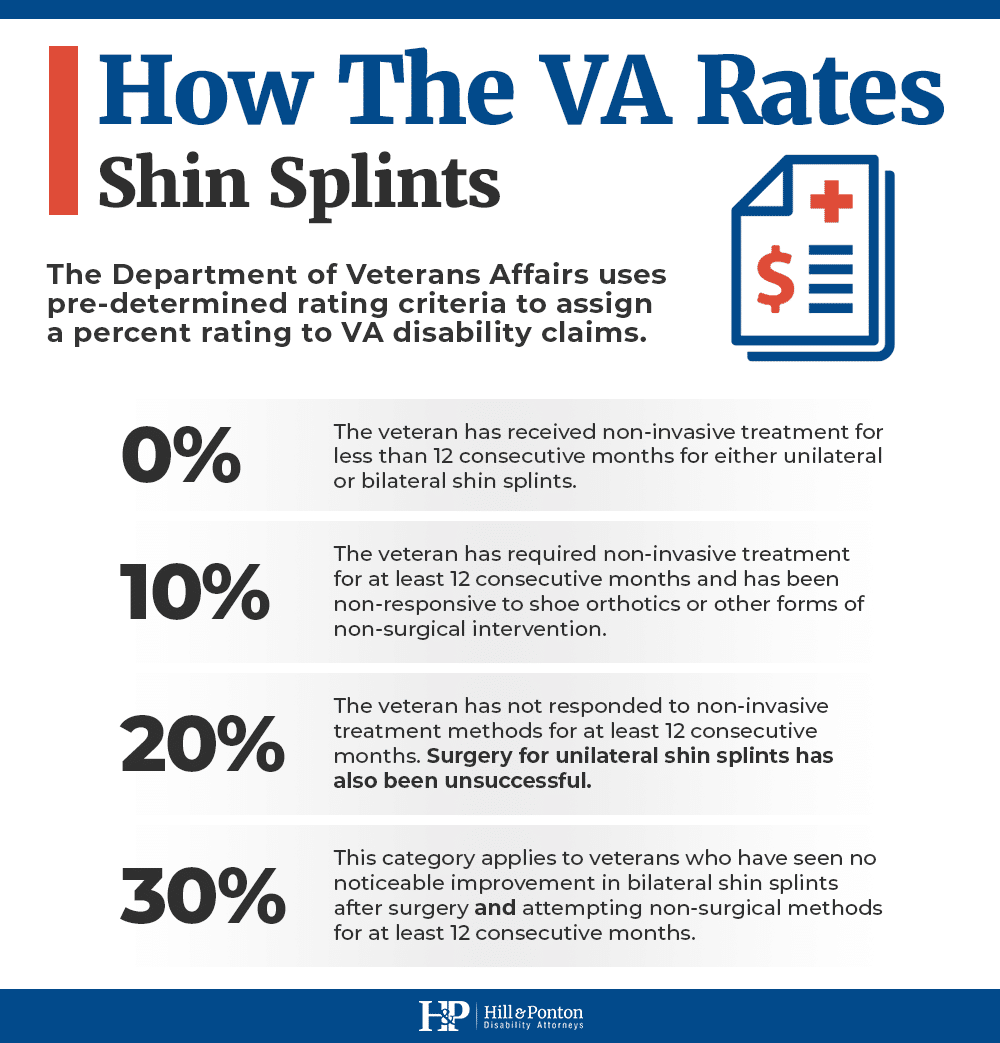The Mayo Clinic describes shin splints as persistent pain in the large bone of the lower leg known as the tibia. Shin splints are common among people who have completed military service along with dancers and runners. The formal medical name for shin splints is medial tibial stress syndrome, and it typically occurs due to overuse of the lower legs while in combat or training. The excessive wear on the lower legs causes bone tissue, muscles, and tendons to become weak from overuse.
Veterans who experience degenerative arthritis, functional loss, or who have gone through amputation of the lower legs due to shin splints may be eligible for VA disability compensation if they can prove a service connection for their functional impairment.
VA Disability Ratings for Shin Splints
The Department of Veterans Affairs uses pre-determined rating criteria to assign a percent rating for VA disability claims. The rating schedule for shin splints is as follows:
- 0 percent: The veteran has received non-invasive treatment for less than 12 consecutive months for either unilateral or bilateral shin splints. Unilateral refers to musculoskeletal dysfunction in one leg and bilateral refers to ongoing leg pain in both legs.
- 10 percent: The veteran has required non-invasive treatment for at least 12 consecutive months and has been non-responsive to shoe orthotics or other forms of non-surgical intervention.
- 20 percent: The veteran has not responded to non-invasive treatment methods for at least 12 consecutive months. Surgery for unilateral shin splints has also been unsuccessful.
- 30 percent: This category applies to veterans who have seen no noticeable improvement for bilateral shin splints after surgery and attempting non-surgical methods for at least 12 consecutive months.
As of February 7, 2021, the Department of Veterans Affairs does not require doctors to take an X-ray to make a positive diagnosis of unilateral or bilateral shin splints. The following treatments meet the definition of conservative interventions for VA rating purposes:
- Compression socks
- Elevation
- Ice
- Medication
- Massage
- Rest

How VA Rates Shin Splints
According to the Mayo Clinic, pain, tenderness, or soreness along the inner side of the shin bone or swelling in the lower leg are the most common symptoms of shin splints. Most veterans notice they have limited motion in the lower legs when they attempt to exercise, but the pain quickly goes away when they stop. Once the pain becomes continuous, it could indicate that the veteran has experienced a stress fracture or stress reaction that requires ongoing medical treatment.
Shin splints develop due to ongoing stress on the shinbone and the connective tissues of the lower leg that attach bone and muscles together. Veterans considering applying for disability benefits with the Department of Veterans Affairs can learn more about shin splints by watching this video produced by the Institute of Human Anatomy.
Having one or more of the risk factors listed below can increase the chances of developing a functional impairment due to shin splints:
- A sudden increase in the duration, intensity, or frequency of exercise
- High arches or flat feet
- Military service and training
- Running on uneven terrain or uneven surfaces
- Repetitive motions that cause anterior leg or knee joint stress
- Overweight or obese condition
- Performing repetitive painful motions
Some veterans find relief from shin splints and other lower leg conditions, such as tendinitis, ligament damage, stress fractures, or artery entrapment syndrome by completing certain exercises at home. Even so, veterans should not hesitate to schedule a medical appointment for evaluation of shin splints if treatment methods such as stretching the Achilles tendon or using over-the-counter medication fail to bring relief.
Service Connection for Shin Splints
Veteran’s claims must meet three specific criteria for the Department of Veterans Affairs to assign a disability rating, a diagnostic code, and approve special monthly compensation. First, they must receive an official diagnosis of shin splints or tibial stress syndrome from their doctor. Secondly, the cause of the lower leg condition must be related to an in-service incident or occurrence that caused or worsened the problem. Lastly, the veteran will need to provide a medical nexus that connects the current diagnosis of shin splints to an in-service occurrence.
Shin splints are so common among military trainees that up to 70 percent of recruits develop them during or after active duty. Other common lower leg/lower extremity and foot conditions due to overuse of these muscle groups include plantar fasciitis, Achilles tendonitis, patellofemoral dysfunction, fibula damage, and stress fractures. Despite the commonality of the diagnosis, veterans will need to obtain written verification from their doctor that specifically outlines the type of military training that caused limited motion or functional impairment of the lower legs.

Secondary Service Connection for Shin Splints
When it comes to entitlement for VA benefits, shin splints are sometimes secondary to other conditions. For example, the veteran may have already had chronic pain in another area of the body that caused shin splints to develop or worsen. Any condition that veterans develop because of a primary condition, could make them eligible for a higher rating (compensable rating) overall and greater compensation.
Service Connection by Aggravation
Veterans may be eligible for VA disability compensation if they had shin splints or another lower leg condition upon entering the military and military service made it worse. With service connection by aggravation VA disability claims, veterans must prove that a diagnosis of shin splints or tibial stress syndrome was already present in their medical chart at the start of their military service using medical records. They also need to provide medical evidence that their lower leg condition worsened due to military service and not aging or normal disease progression.
Compensation & Pension Exams for Shin Splints
When the Department of Veterans Affairs does not feel like it has enough medical information to determine if the veteran has a service-connected disability, the veteran applying for VA disability claims will need to schedule a compensation & pension (C & P) exam. The purpose of this exam is for the military doctor to examine the veteran and take X-rays to provide additional evidence for that person’s VA disability claim.
VA doctors frequently code shin splints as compartment syndrome or stress fractures. Former soldiers should always confirm their official diagnosis with their doctor before completing the process of applying for veteran’s disability benefits.
Some specific lower leg and foot injuries doctors look for with veterans claims include:
- ankle disability
- limited weight-bearing ability
- painful flare-ups
- muscle dislocation or fatigability
- painful range of motion ankle disability
- limitation of motion (measured & defined with a goniometer)
- overall functional impairment
Veterans who receive a report from their C & P exam that does not support their entitlement to VA disability compensation have the right to file an appeal.
TDIU for Shin Splints
The abbreviation ‘TDIU’ stands for total disability individual unemployability and is a unique VA program for military service veterans. This program TDIU serves veterans who have a combined disability rating of 100 percent from one or more disability ratings may be eligible to apply for TDIU. However, the other disabilities will need to have at least a 70 percent rating between them to push the total disability to 100 percent. This is due to the Department of Veterans Affairs assigning a maximum disability rating of 30 percent for shin splints.

Hill & Ponton Law Firm Serves the Disabled Veteran Community
Serving the United States through military service and then dealing with a disability can be a frustrating and overwhelming experience. Hill & Ponton, a veteran’s rights and disability law firm with dozens of satellite locations across the country, has helped thousands of veterans through the process of obtaining the disability benefits they deserve. We invite veterans to complete a VA Case Evaluation on our website to learn more.




